|
TRANSLATIONS
The first of the bird list pages:
|
The bird
list from Manuscript E according to Barthel 2 and after my
'upgrading' (cfr at rona):
|
manu tara |
tavake |
|
pi riuriu |
ruru |
|
kava eoeo |
taiko |
|
te verovero |
kumara |
|
ka araara |
kiakia |
|
kukuru toua |
tuvi |
|
makohe |
tuao |
|
kena |
tavi |
There is no obvious bird name here similar to kea. The closest fit
is kiakia, the 5th bird in the 2nd half of the list. Barthel
2:
"In a short recitation that accompanies a string
game, the next bird on the list, kiakia (number 13), the
white tern, is associated with the leaves of the sweet potato:
| kiakia kiakia |
The white terns |
| tari rau kumara |
carry the leaves of sweet potatoes in
their beaks." |
Tari is the first part of tariga (ear),
from which we could guess the function of an ear, viz. to carry
pendants.
|
Tari
1. To take from one place to another;
he-tari-mai, to bring. 2. Upper end of the
sugarcane, which was used in military training as a
harmless weapon. Tariga, ear; tariga pogeha,
tariga pó, sordo; tariga maîka, bunch of
bananas. Vanaga.
1. To pluck, to gather, to reap, to
load; kai taria te kai, abundance. 2. To lead, to
carry; hakatari, to conduct, to guide, to direct,
to escort, to carry, to bring, to pay; hakatari miro,
pilot; hakatariga, payment. Tariga, ear,
earring; tariga hakarogo, faithful, observant,
submissive; tariga kikiu, din, buzzing; tariga
meitaki, to have good hearing; tariga pogeha,
deaf, to disobey; tariga puru, disobedient;
tariga purua, stubborn; tarigariga, chain.
Tarirapa, to gather. Churchill |
However, tari means to take from one place to
another, and the word could therefore rather be an allusion to the
'whirlpool' (cfr under Hatinga Te Kohe in the excursion at
haati). The ear looks like a whirlpool and in a whirlpool you will be carried away, in myth to some
other place:
... taken round and
round to the very lowest center of the whirlpool, when another
circle caught him and bore him outward. He told afterwards that when
he reached the narrowest circle of the maelstroem the water seemed
to open below and he could look down as through the roof beam of a
house, and there on the bottom of the river he had seen a great
company, who looked up and beckoned to him to join them ...
Fornander ought to have identified the equality of
sound and meaning between
'to carry' and the Hawaiian version of tari (which should
be kali), I thought. However, he instead has identified
Hawaiian kali with 'to tarry', because kali means 'to
wait, to tarry, to stay, expect, hesitate'. This kali is the
opposite of being carried away, and therefore we can anyhow see a
connection between tari and kali.
So much is clear, though, that kiakia indeed is a white (tea)
bird. Number 13 fits it better than number 5, because a white bird
is coloured like old bleached bones.
Maybe there is a link here to the crab, which has
neither feathers nor any other growth on its outside - crustaceans
illustrate the state of death. If so, then pikea could
signify death and kea
could be its opposite (like the bright-coloured lively thrush).
Maybe tea is the light from Moon and kea
the light from Sun. Makea tutara was the father of
Maui - cfr 'How Maui gave mortality to Man' (among the
myths in my Index) - and names are significant.
According to Churchill kiakia could possibly be a general
term for white birds:
| Kiakia
Dove, gull T. Mgv.: kiakia, the cry of the kotake (a white
marine bird). Churchill. |
But there is no place for a thrush or a dove in a list of sea birds,
and the gull is not represented.
|
To carry the leaves of kumara in the beak is - I
think - quite close in meaning to how on New Zealand it was said
that Rongo brought the sweet potato in his penis to
impregnate his wife, Pani, the field:
|
...
If I am allowed to
lift a page from The Golden Bough: each year the
sylvan landscape of old New Zealand provided 'the scene
of a strange and recurring tragedy.' In a small
sweet-potato garden set apart for the god, a Maori
priest enacted a sacred marriage that would be worthy of
his legendary colleague of the grove of Nemi.
Accompanying his movements with a chant that included
the phrase, 'Be pregnant, be pregnant', the priest
planted the first hillocks (puke, also 'mons
veneris') of the year's crop. The priest plays the part
of the god Rongo (-marae-roa, Ha., Lono),
he who originally brought the sweet potato in his penis
from the spiritual homeland, to impregnate his wife (Pani,
the field) ... |
The penis of man corresponds to the beak of the bird.
It could, one might think, also correspond to the
prow of a ship, but ships are female. On the
prow of Pharaoh's ship down in the Underworld a swallow is
perching, we have seen:
The swallow corresponds to the spirit of Pharaoh,
and it functions as the bow-spr(ir)it, from which he will be
reborn:
"sprit ... pole ... boom or pole crossing
a sail diagonally ... f. Germ. *spreut- sprût-; see SPROUT ...
sprout ... shoot forth, spring up ..." (English
Etymology)
The strangely formed bow in the picture has 7 + 6
= 13 dotted oval forms in front and 8 on the back side (inside).
Presumably these 8 + 13 ovals correspond to the dark time
respectively the time when Pharaoh is alive again. Twice 21 is
the number of judges in the Underworld:

Apparently kiakia must be connected with procreation. A
further sign of this is rau (leaves), which exemplifies
how life is returning from its dormant Underworld phase.
On Easter Island rau means 100 but in the Maori dialect
it means 1000. The general idea is 'plenty' (of offspring).
The sweet potato (kumara) must be buried in order to
sprout.
|
|
Below I have updated the bird list:
|
manu tara |
sooty tern |
tavake |
redtailed tropic bird |
|
pi riuriu |
d:o |
ruru |
black petrel |
|
kava eoeo |
d:o |
taiko |
|
te verovero |
d:o |
kumara |
white tern |
|
ka araara |
d:o |
kiakia |
|
kukuru toua |
albatross ? |
tuvi |
gray tern |
|
makohe |
frigate |
tuao |
dark brown tern |
|
kena |
booby |
tavi |
small lead-coloured tern |
I have
combined kumara with kiakia into a single
white tern, because kumara apparently is closely
connected with kiakia. Likewise I have combined ruru with
taiko into a single item:
"The
next two names on the list are ruru and taiko
(numbers 10 and 11). While those two represent two different
species, it should be pointed out that the combined name
ruru-taiko refers in MAO. to a black petrel (Procellaria
parkinsoni).
There
are no cultural data available for ruru, which seems to
be derived from PPN. *lulu 'owl', or for taiko
(compare RAR. taiko 'black petrel', MGV. tiaku
'petrel?, omen of death'), but the textual association of
taiko and spirits should be kept in mind (Campbell
1971:113)." (Barthel 2)
The
picture below is from Wikipedia and the artist is Joseph Smit
(1896):

Owls
arrive with the night, and we should remember where the owl is
located in the Mayan calendar.
My idea is that the
list should be reorganized into 9 + 5 = 14 items (or rather into
8 + 5 = 13 items, which will be motivated below). My double bird
items ought to indicate the 2nd part of the list, i.e. the redtailed tavake
should be the last bird of the 1st part.
Page 72 of Manuscript E is where these birds
are located and page 72 (= 360 / 5) enumerates 20 * 15 = 300 birds, which
we immediately can identify as the 10-month cycle of Sun. 20 * 15 = 10
* 30, i.e. there are 2 halfmonths in each month.
Manu
tara, the first name mentioned on the page is a special case, therefore there are not 16 but 15
times 20:
he
manu tara.erua kauatu te huru.i too mai ai
With
items 2-5 in the table above (pi riuriu, kava eoeo,
te verovero, and ka araara) being the development
stages of young manu tara birds it is also clear that
the first bird, manu tara, is more of an introduction than a real item on the
list.
We need to investigate what
kauatu te huru.i too mai ai
might mean.
|
At hanga rave I have presented the
following table describing a Mayan calendar with 18 months à
20 days together with a final 5-day long special month:
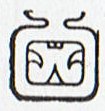 |
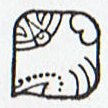 |
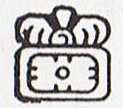 |
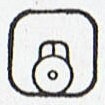 |
|
5
Tzek |
6
Xul |
7
Yaxkin |
8
Mol |
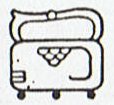 |
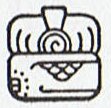 |
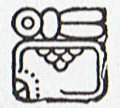 |
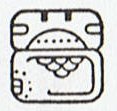 |
|
9
Ch'en |
10
Yax |
11
Sac |
12
Ceh |
 |
 |
200 |
 |
|
13
Mac |
14
Kankin |
15
Moan |
 |
 |
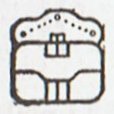 |
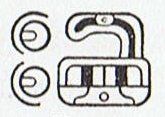 |
|
16 Pax |
17
Kayab |
18 Cumhu |
19 Vayeb |
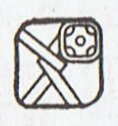 |
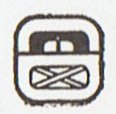 |
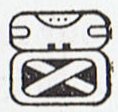 |
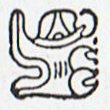 |
|
1
Pop |
2
Uo |
3
Zip |
4
Zotz |
...
After studying glyphs, names and other aspects (ref. mainly
Gates and Kelley) I arranged the months into the pattern
above, with 10 redmarked months for 'summer', and with
'winter' being divided in two equal parts by the 19th
exceptional 5-day month. 200 + 80 + 5 + 80 = 365 ...
My arrangement has 15 Moan as the
first month of 'winter', i.e. the time of the year
corresponding to when sun has gone down in the west in the
evening. The mouth which opened wide in spring (cfr 4
Zotz) to allow Sun to enter (in 5 Tzek) has
closed again in 15 Moan to show that darkness has returned.
The outside 3 black dots in 16 Pax are much greater
than those in 9 Ch'en. Darkness falls first with the
onset of the rain clouds (the grapelike hanging formation) and then when Sun leaves in autumn.
15 Moan is my candidate for an owl. However, Gates is
of the opinion that it is a falcon:
"Six glyphs at
least are clearly pictographic in base: Pop, mat;
Sotz, bat; Xul, ?; Kankin, skeleton ribs;
Moan, falcon; Kayab, turtle." (Gates)
The 'skeleton ribs' in 14 Kankin
should
be regarded as a version of the 'Tree', I guess. Beyond the
'Tree' comes the 'Fall', after 200 days of 'summer'. 15
Moan could also be imagined as the month of the Vulture,
someone has to take care of the fallen body. Counted from
new year to 15 Moan a period of 80 + 200 = 280 = 10 *
28 days has finished. After 280 days of
light (the first 80 days with light from Moon only and then
200 days with Sun present) the region of 'water' lies ahead:
"... The origin
and explanation of the custom [of sacred water] is thus
given in the Hawaiian 'Kumuhonua' legend:
The Ocean,
ka moana nui a Kane, which surrounds the earth, was made
salt by Kane, so that its waters should not stink,
and to keep it thus in a healthy and uninfected state is the
special occupation of Kane.
In imitation of
Kane, therefore, the priests prepared waters of
purification, prayer, and sanctification, Wai-hui-kala,
Wai-lupa-lupa, and ke kai-olena, for the
public ceremonials, for private consolation, and to drive
away demons and diseases.
Such
holy waters were called by the general name of ka wai
kapu a Kane.
From the
sprinkling of a new-born child to the washing of the dying,
its application was constant and multifarious. The baptismal
ceremony - E Riri - of the New Zealanders, related by
Dieffenbach, with the accompanying prayers invoking the gods
Tu and Rongo (the Hawaiian Ku and
Lono), is a valuable and remarkable remnant of the
ancient culte. It was a necessary adjunct in private and
public worship, a vade mecum in life, a viaticum
in death; and even now, fifty years after the introduction
of Christianity in these Hawaiian islands, there are few of
the older people who would forego its use to alleviate pain
and remove disease." (Fornander)
The 'ocean' (moana) begins -
according to my interpretation - with 15 Moan (in
Polynesian a word cannot end with a consonant) and 'land' is
now in the past. Slight differences between words which
basically are the same must be expected. For instance is
muan probably an alternatively spelled moan (picture from
Kelley):
The 'turkey' in front of
the 'owl' has a Sun eye and carries 3 + 4 = 7 'stones'
on his head (3 in front and 4 at the back). The artist has above the head arranged number 8 (formed from 3 dots and a bar). Above
the 'owl' we can see 4 dots and then the picture seems
to be damaged, but I guess another 4 dots arrive after
the 4 black dots. But these later and half hidden dots
are white. The 'owl' is the female Moon and she follows
the male Sun (we must read from right to left when
looking at Mayan texts).
The Sun 'turkey' has 2 white dots and 2
white bars above his tail, and it means number 12 (= 2 + 2 * 5). Together with the 'black' 3 + 5 = 8 it becomes 20. The
black-and white reproduction does not tell what the real
colours were, which we see as black and white. And there certainly
are many more details to be considered in the pictures.
The main point is clear, though, the owl represents
Moon.
|
|